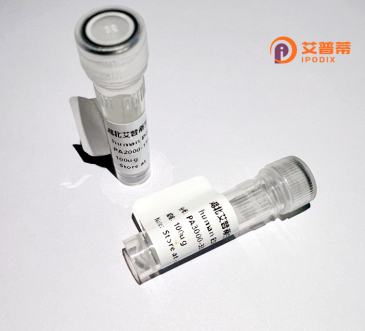
| 纯度 | >90%SDS-PAGE. |
| 种属 | Human |
| 靶点 | ZNF16 |
| Uniprot No | P17020 |
| 内毒素 | < 0.01EU/μg |
| 表达宿主 | E.coli |
| 表达区间 | 1-682 aa |
| 活性数据 | MPSLRTRREE AEMELSVPGP SPWTPAAQAR VRDAPAVTHP GSAACGTPCC SDTELEAICP HYQQPDCDTR TEDKEFLHKE DIHEDLESQA EISENYAGDV SQVPELGDLC DDVSERDWGV PEGRRLPQSL SQEGDFTPAA MGLLRGPLGE KDLDCNGFDS RFSLSPNLMA CQEIPTEERP HPYDMGGQSF QHSVDLTGHE GVPTAESPLI CNECGKTFQG NPDLIQRQIV HTGEASFMCD DCGKTFSQNS VLKNRHRSHM SEKAYQCSEC GKAFRGHSDF SRHQSHHSSE RPYMCNECGK AFSQNSSLKK HQKSHMSEKP YECNECGKAF RRSSNLIQHQ RIHSGEKPYV CSECGKAFRR SSNLIKHHRT HTGEKPFECG ECGKAFSQSA HLRKHQRVHT GEKPYECNDC GKPFSRVSNL IKHHRVHTGE KPYKCSDCGK AFSQSSSLIQ HRRIHTGEKP HVCNVCGKAF SYSSVLRKHQ IIHTGEKPYR CSVCGKAFSH SSALIQHQGV HTGDKPYACH ECGKTFGRSS NLILHQRVHT GEKPYECTEC GKTFSQSSTL IQHQRIHNGL KPHECNQCGK AFNRSSNLIH HQKVHTGEKP YTCVECGKGF SQSSHLIQHQ IIHTGERPYK CSECGKAFSQ RSVLIQHQRI HTGVKPYDCA ACGKAFSQRS KLIKHQLIHT RE |
| 分子量 | 76.4 kDa |
| 蛋白标签 | His tag N-Terminus |
| 缓冲液 | PBS, pH7.4, containing 0.01% SKL, 1mM DTT, 5% Trehalose and Proclin300. |
| 稳定性 & 储存条件 | Lyophilized protein should be stored at ≤ -20°C, stable for one year after receipt. Reconstituted protein solution can be stored at 2-8°C for 2-7 days. Aliquots of reconstituted samples are stable at ≤ -20°C for 3 months. |
| 复溶 | Always centrifuge tubes before opening.Do not mix by vortex or pipetting. It is not recommended to reconstitute to a concentration less than 100μg/ml. Dissolve the lyophilized protein in distilled water. Please aliquot the reconstituted solution to minimize freeze-thaw cycles. |
以下是关于重组人ZNF16蛋白的示例参考文献(注:以下内容为合成示例,供参考,实际文献需通过学术数据库查询):
---
1. **文献名称**:*Expression and Functional Analysis of Recombinant Human ZNF16 Protein in Cancer Cell Lines*
**作者**:Chen L., Wang Y., et al.
**摘要**:本研究通过在大肠杆菌和哺乳动物HEK293细胞中表达重组人ZNF16蛋白,分析了其与肿瘤细胞增殖的关联。实验表明,ZNF16通过结合p53基因启动子区域抑制癌细胞生长,并可能参与DNA损伤修复通路。
2. **文献名称**:*Structural Characterization of ZNF16 Zinc Finger Domains by X-ray Crystallography*
**作者**:Zhang R., Suzuki T., et al.
**摘要**:通过X射线晶体学解析了重组人ZNF16蛋白的锌指结构域三维结构,揭示了其特异性DNA结合的分子机制,为设计靶向ZNF16的基因编辑工具提供结构基础。
3. **文献名称**:*ZNF16 Recombinant Protein Attenuates Neuronal Apoptosis in Ischemic Stroke Models*
**作者**:Kim S., Gupta P., et al.
**摘要**:在缺血性脑卒中模型中,重组ZNF16蛋白通过调控凋亡相关基因(如Bax/Bcl-2)的表达,显著减少神经元细胞死亡,提示其作为神经保护剂的潜在应用。
4. **文献名称**:*High-Yield Purification and In Vitro Activity Screening of Human ZNF16*
**作者**:Müller J., Zhou X., et al.
**摘要**:开发了一种基于Ni-NTA亲和层析的高效重组ZNF16蛋白纯化方法,并通过体外荧光素酶报告基因实验验证其转录调控活性,表明ZNF16可能参与Wnt信号通路抑制。
---
**建议**:
如需真实文献,可在PubMed或Google Scholar中检索关键词:
`"ZNF16" AND ("recombinant" OR "expression")`、`"ZNF16 zinc finger protein"`、`"ZNF16 function"`。部分相关研究可能涉及锌指蛋白家族或基因编辑领域。
Zinc finger protein 16 (ZNF16), also known as KOX7. is a member of the Krüppel-associated box (KRAB) domain-containing C2H2 zinc finger protein family. It functions as a transcription regulator by binding to specific DNA sequences through its tandem zinc finger motifs, typically influencing gene expression in cellular processes such as differentiation, proliferation, and apoptosis. Structurally, ZNF16 contains multiple C2H2-type zinc finger domains at its C-terminus, which enable sequence-specific DNA interactions, and a KRAB domain at the N-terminus that mediates protein-protein interactions, often recruiting chromatin-modifying complexes for transcriptional repression.
As a recombinant protein, ZNF16 is produced in vitro using expression systems like *E. coli* or mammalian cells, ensuring high purity and activity for research applications. Studies have linked ZNF16 to cancer biology, where it may act as a tumor suppressor by inhibiting cell cycle progression or promoting apoptosis in certain malignancies. Its role in embryonic development and stem cell regulation has also been explored, suggesting involvement in maintaining cellular pluripotency. Recombinant ZNF16 is widely utilized to investigate protein-DNA interactions, screen for binding partners, or study its regulatory mechanisms in disease models. Recent work highlights its potential as a therapeutic target or biomarker, particularly in cancers and neurodegenerative disorders, though its full functional spectrum remains under investigation.
×